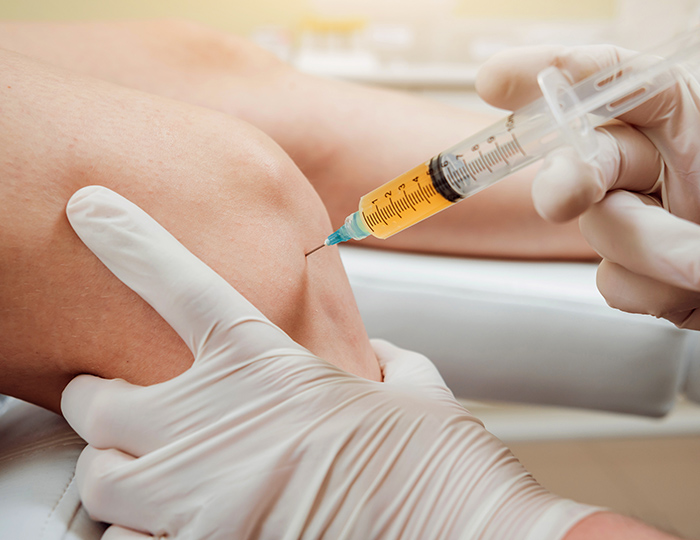Joint pain is an exceptionally common problem that can have a substantial impact on a person's lifestyle. In the past, individuals would need to rely on using prescription medications and even surgical treatment to help in reducing the discomfort and pain connected with joint pain. However, nowadays, there is a much more natural and effective way to treat joint pain. Platelet Rich Plasma (PRP) therapy has become increasingly popular over the past couple of years and is getting recognition as a practical treatment choice for joint discomfort. This extensive guide will provide an introduction of PRP therapy and how it can assist treat joint pain. It will cover whatever from how PRP works to the different types of PRP treatments available, as well as the potential benefits and risks related to this technique of treatment. By the end of this guide, you will have a much better understanding of PRP therapy and how it can be used to effectively treat joint pain.
What is Platelet Abundant Plasma (PRP) Treatment?
PRP treatment is a procedure that includes drawing out a sample of blood from the client, isolating the platelets within the blood, and then re-injecting the platelets back into the client's injured or uncomfortable joint. Basically, the platelets are what make PRP therapy so reliable. Platelets are naturally taking place blood elements that are abundant in development elements. Growth elements are proteins that stimulate cellular regrowth and tissue repair, which is why they are used in numerous various types of medical treatments. By extracting the platelets out of the patient's blood sample and re-injecting them back into the client's injured joint, they are basically supplying their body with the essential proteins needed to start the healing procedure. This process can help deal with a range of various conditions and injuries such
How Does PRP Therapy Work?
When the platelets are extracted from the patient's blood sample and re-injected back into the client, they promote the recovery process in the patient's hurt joint. The development aspects within the platelets are what are responsible for promoting this healing process. Essentially, the platelets serve as little bio-factories that produce proteins which assist to promote the healing procedure and accelerate healing time. As the platelets are re-injected back into the client's injured joint, they activate the body's own healing process and aid to minimize the discomfort and inflammation related to the injury. They also assist to promote a more quick recovery process, resulting in fewer down-time durations and a quicker go back to regular daily activities. By dealing with joint pain with PRP therapy, you can help reduce joint pain, boost movement, and speed up your recovery time.
What are the Advantages of PRP Therapy for Joint Pain?
As PRP treatment is so effective at reducing joint discomfort, discomfort, and inflammation, it is the perfect treatment choice for anybody who is experiencing joint pain. PRP therapy is able to decrease the pain and pain connected with joint pain by stimulating the body's own healing procedure and naturally speeding up the rate of healing time. PRP therapy is likewise extremely effective at helping to increase movement in the affected joint and reducing the threat of stiffness and swelling. As the body's recovery process is naturally accelerated, you will likely discover that your joint pain subsides far more quickly and you will have the ability to return to your routine everyday activities more quickly than you would if you were to count on prescription medications. PRP treatment is a much more natural and reliable approach to dealing with joint pain, and is incredibly advantageous because it is minimally intrusive and does not require any down time periods.
What are the Various Kinds Of PRP Treatments for Joint Pain?
For each individual, there are various kinds of PRP treatments that can be used for treating joint discomfort. For instance, if you are suffering from knee pain, you might go with a PRP injection into your knee joint. This treatment can be used to treat a variety of conditions consisting of: arthritis, osteoarthritis, rheumatoid arthritis, joint separation, muscle sprains, and tendonitis. There are likewise various types of PRP injections that can be used to treat various locations of the body, consisting of the knees, shoulders, elbows, and wrists.
What are the Potential Risks and Adverse Effects of PRP Treatment?
As PRP therapy is a natural and efficient way to deal with joint discomfort and speed up the recovery procedure, it is incredibly safe and comes with extremely couple of side effects or dangers. Essentially, PRP treatment is just utilizing the client's own blood and there are essentially no risks related to PRP. Although PRP therapy is extremely safe and efficient, there are some things to be familiar with prior to going through the treatment. PRP treatment might take a little longer to begin working as it is a more natural and slower process than taking medications. It is essential to keep in mind that not everyone will respond to PRP therapy, and it is essential to discuss your choices with your physician.
platelet-rich plasma injection for shoulder pain
How to Prepare for PRP Therapy?
Prior to you schedule an appointment for PRP treatment, it is very important to guarantee that it is the ideal treatment option for you. PRP therapy is finest matched for people who are experiencing chronic discomfort or pain that is triggered by an injury or a specific condition. For instance, if you have been identified with arthritis and experience a great deal of pain and discomfort in your knees and joints, PRP treatment could be an excellent alternative for treating your pain. PRP treatment is minimally invasive, so there is no need to fret about an invasive or dangerous surgery. PRP therapy can likewise be used to deal with sports injuries and help speed up the recovery procedure. For PRP therapy, you will require to guarantee that you are in health which your body has no current health problems or infections. You will also require to make certain that you are not taking any blood thinning medications as these can disrupt the effectiveness of PRP treatment.
What to Anticipate During PRP Therapy?
PRP treatment is a relatively simple treatment that takes really little time to finish. The primary step in the process is to draw blood from the client and isolate the platelets from the sample. The blood sample is placed in a centrifuge and spun around to separate out the platelets and blood cells. Then, the platelets are re-injected back into the patient's injured joint and the blood cells are discarded. The entire procedure is extremely safe and painless, and is often done as an outpatient procedure in a center or physician's office. You will only need to be in the center for a couple of hours and you will be able to go house after the procedure and rest as you usually would. Depending upon the type of PRP therapy you are receiving, there might be some mild to moderate swelling, however this should go away within a few days after the treatment.
What to Anticipate After PRP Therapy?
After you have undergone PRP treatment, you will likely discover a nearly instant improvement in your joint discomfort and increased movement. As the platelets are naturally healing your joint and accelerating the body's natural recovery process, you ought to see an improvement within a few days. It is most likely, nevertheless, that you will discover the most significant difference in between PRP therapy and routine medications after about a week. After PRP treatment, it is essential to rest and enable your joint to recover, but you must have the ability to go back to your regular everyday activities earlier than you would after taking a regular discomfort medication. Among the very best aspects of PRP treatment is that it does not need you to take any drugs, so you don't have to stress over possible negative effects or long-lasting health issues.
What are the Expenses of PRP Treatment?
The cost of PRP treatment can vary depending on the private clinic or medical professional's workplace where you choose to have actually the procedure carried out. PRP therapy is a minimally invasive procedure that is typically completed as an outpatient treatment and does not require any down time. As such, PRP treatment is typically more cost effective than many other treatment alternatives. Depending upon the clinic you go to and what type of PRP therapy you get, the costs of PRP treatment can range from a couple of hundred dollars to a couple of thousand dollars. Remember that PRP therapy is a much more natural treatment choice that helps to speed up the body's own healing process and is normally much safer and more budget-friendly than taking prescription medications. As such, it is very important to do your research study and speak with your physician to determine if PRP therapy is the very best treatment choice for you.

This functional health article has been promoted by Joint Repair Clinic of Montana.
Joint Repair Clinic of Montana is a functional health center within the Missoula area. Joint Repair Clinic of Montana provides ozone treatment.
Joint Repair Clinic of Montana
2801 Great Northern Loop
Missoula, MT 59808
(406) click here 510-1388
https://www.jointrepairmt.com/missoula

Comments on “A Comprehensive Guide to Platelet Rich Plasma Therapy for Treating Joint Discomfort”